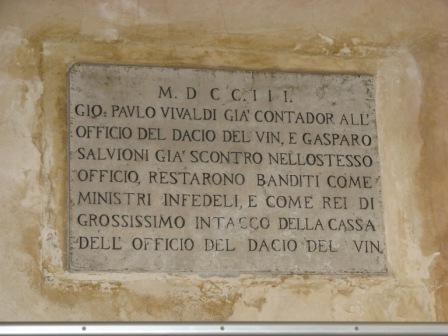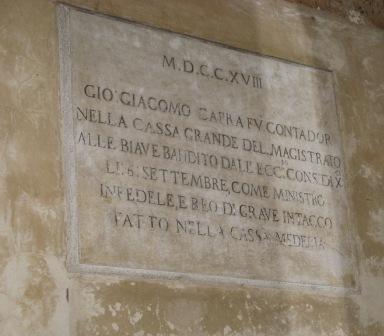One of the fundamental elements of Venice’s national mythology was that her government was just, equitable, and fair; that the law was equal for all, and that corruption, corner-cutting, re-interpretation of certain inconvenient clauses, and other such variations on the theme of smashing all ten commandments, would not only not be tolerated, they should be virtually unknown. Hence the elegant figure of Justice depicted in prominent places (including the campanile of San Marco; perhaps a little hard to appreciate from her perch atop two lions at 324 feet high, but all the more imposing for that), complete with blindfold, scales and sword.
However, human nature being what it is/was/and evermore shall be, there were occasional individuals who fell off the bandwagon. Self-interest is a powerful force, even when it turns out that whatever you did actually accomplished the opposite of your goal. Like poaching.
There are several plaques in the entryway to the Doge’s Palace. I don’t know if these were their original positions; on the one hand I’d tend to think so, because certain kinds of news really needed to be made public. That was part of the punishment, even though at the time everybody already knew the story, but seeing it there, incised in stone, must have added to the general unpleasantness. For the perp, I mean, not for the government (very pleased with itself) or his enemies and/or victims (glad to extremely glad). But the wear these plaques have suffered leads me to suspect they were placed outside, exposed to the elements for a longish time, which would have increased their publicity value.
You will notice that the commandment that has been smithereened at least four times in Venetian history is #8.
I will let them speak for themselves:



While we’re on the subject of Crime and Banishment, it wasn’t as heavy a penalty as it sounds, because it almost never lasted for very long. It certainly didn’t last forever. Like various family fights, it often became clear after a while that it would be better for all concerned just to get on with things. In the meantime, however, because they had been “bandito,” that is, banished, they were, in fact, bandits.
Provender: Otherwise known as biade, or biave. The biavaroli sold cereals and legumes — dried beans, split peas, chickpeas, spelt, and so on — and were subject to strict public regulation, to wit: First, the members of the guild had to swear an oath that they wouldn’t cheat by putting better wheat on top of inferior moldy skanky wheat. So far, so good.
Then, the product had to be registered before it could be sold, in the registry maintained in the public fondaco, or warehouse, at Rialto. The vendors were forbidden (of course, there’s nothing simpler than forbidding, but I’m just reporting here) to suggest to their retailers that they charge any price which would vary from the officially established figure. Their shops were state property. Those who sold wheat were forbidden to sell barley and NOBODY was allowed to keep merchandise acquired from two different suppliers.
But as we see by the plaques above, laws and decrees are only as good as the people who carry them out. Or not.
Before we move on, you should know that near the Doge’s Palace there was a garden; in Venetian, called a brolo. In Italian, broglio. Here the senators would find themselves before a vote in the Great Council, in order to do a little horse-trading with their votes. Hence the word “imbroglio,” which has about 30 different meanings nowadays ranging from bunko and chicanery and flimflam to fraud, hoax and swindle. These were the men who were making these dramatic decrees.
I’d like to write a book about human nature, if I could find the time. And if I could figure out what to say.

2 Comments
Does the palace need a new set of plaques for the modern ‘doge bags?
I think by now the entire palace could be covered from floor to attic ceiling with such plaques. Plus ca change…